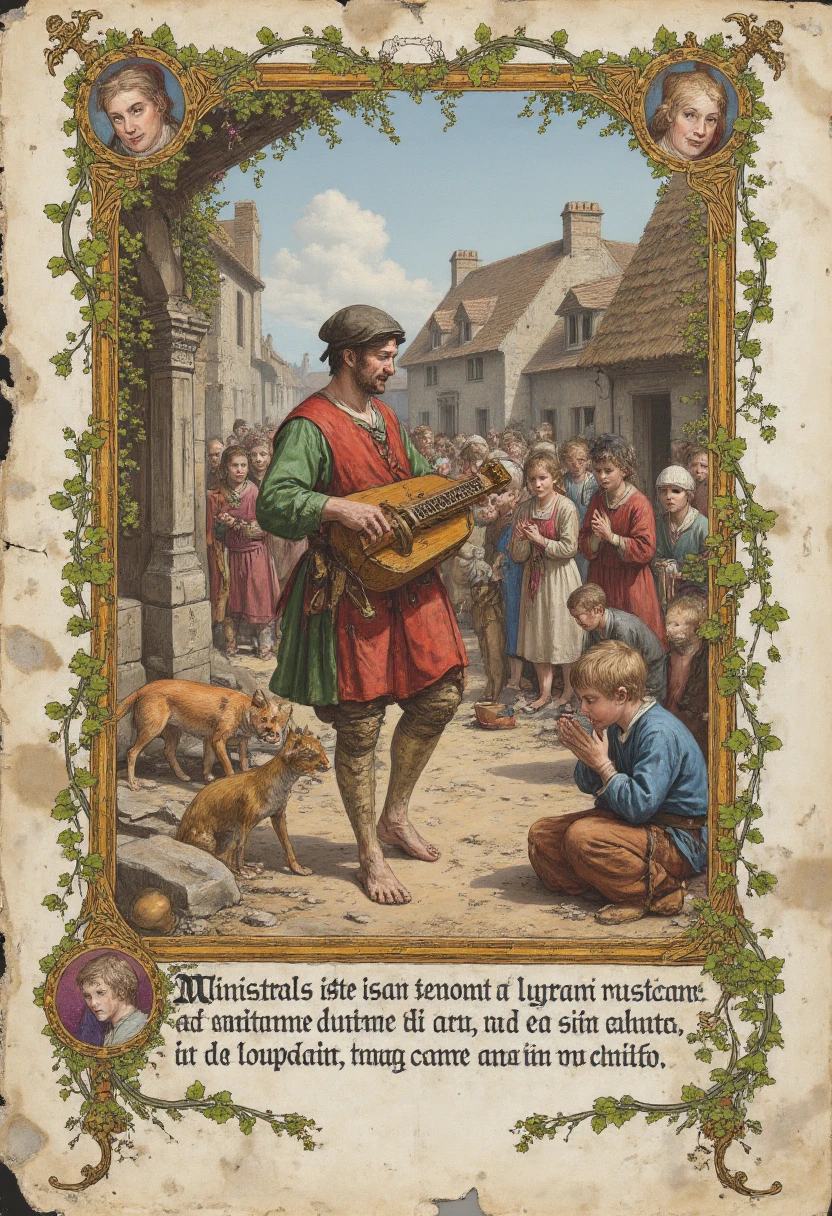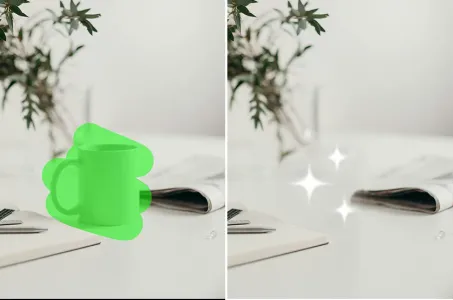Arafed picture of a man playing a lute in a village


Tenho conteúdo excitante, ideal para nós.
A richly detailed medieval manuscript-style illustration depicting a street minstrel playing a hurdy-gurdy, drawn on aged, weathered parchment. The page features signs of wear: torn edges, faint water stains, and smudges from centuries of handling. Faded ink, sepia tones, and uneven pigment application lend authenticity to the artwork. The central figure, the minstrel, is dressed in tattered, brightly colored medieval garb—patched red and green tunic, woolen hose, and a floppy hat adorned with a single feather. His face is slightly unshaven, with a crooked grin and sun-weathered features. The minstrel’s bare feet are calloused and dusty, a testament to his life on the road. He cranks the hurdy-gurdy with one hand while pressing the keys with the other, mid-performance, as if caught in the lively motion of his tune. The hurdy-gurdy in this setting is an intricately crafted medieval piece, its wooden body painted with faded floral motifs and small religious symbols like stars and crosses. The crank is iron and slightly rusted, and the soundboard is scratched from years of use. Tiny brass bells hang from the instrument, jingling softly with each turn of the crank. In the background, a medieval village street is depicted with meticulous detail. Wattle-and-daub cottages lean unevenly against each other, their thatched roofs sagging under the weight of time. Townsfolk—peasants, merchants, and children—gather around the minstrel, some clapping in rhythm, others watching skeptically. A beggar with a wooden bowl sits at the edge of the scene, while a stray dog sniffs the minstrel’s bare feet. The borders of the page are richly illuminated with gothic-style flourishes. Vines, leaves, and berries twist and coil along the edges, interspersed with tiny illustrations of animals: a fox peeking from the corner, a bird perched on the vine, and a mouse nibbling on a grape. In the top corners, two medieval grotesques—a grinning gargoyle and a tiny, impish figure with horns—peer down at the scene, adding a playful touch of medieval humor. Gold leaf has been used sparingly, adding a shimmering effect to the minstrel’s feather, the vines in the border, and the halos of a pair of saints depicted in a small medallion above the scene. Latin script runs across the bottom, slightly faded and uneven, describing the minstrel’s role as a bringer of joy (or mischief) to the village: "Ministral iste resonat lyram rusticam, ad laetitiam et peccata invitans." ("This minstrel plays the rustic lyre, inviting joy and sin alike.") The page feels alive with the texture of its age—creases, small holes where insects have nibbled, and areas where the ink has cracked and flaked. It captures the blend of reverence and whimsy characteristic of medieval manuscripts.
Prompts
Copiar prompts
A richly detailed medieval manuscript-style illustration depicting a street minstrel playing a hurdy-gurdy, drawn on aged, weathered parchment. The page features signs of wear: torn edges, faint water stains, and smudges from centuries of handling. Faded ink, sepia tones, and uneven pigment application lend authenticity to the artwork.
The central figure, the minstrel, is dressed in tattered, brightly colored medieval garb—patched red and green tunic, woolen hose, and a floppy hat adorned with a single feather. His face is slightly unshaven, with a crooked grin and sun-weathered features. The minstrel’s bare feet are calloused and dusty, a testament to his life on the road. He cranks the hurdy-gurdy with one hand while pressing the keys with the other, mid-performance, as if caught in the lively motion of his tune.
The hurdy-gurdy in this setting is an intricately crafted medieval piece, its wooden body painted with faded floral motifs and small religious symbols like stars and crosses. The crank is iron and slightly rusted, and the soundboard is scratched from years of use. Tiny brass bells hang from the instrument, jingling softly with each turn of the crank.
In the background, a medieval village street is depicted with meticulous detail. Wattle-and-daub cottages lean unevenly against each other, their thatched roofs sagging under the weight of time. Townsfolk—peasants, merchants, and children—gather around the minstrel, some clapping in rhythm, others watching skeptically. A beggar with a wooden bowl sits at the edge of the scene, while a stray dog sniffs the minstrel’s bare feet.
The borders of the page are richly illuminated with gothic-style flourishes. Vines, leaves, and berries twist and coil along the edges, interspersed with tiny illustrations of animals: a fox peeking from the corner, a bird perched on the vine, and a mouse nibbling on a grape. In the top corners, two medieval grotesques—a grinning gargoyle and a tiny, impish figure with horns—peer down at the scene, adding a playful touch of medieval humor.
Gold leaf has been used sparingly, adding a shimmering effect to the minstrel’s feather, the vines in the border, and the halos of a pair of saints depicted in a small medallion above the scene. Latin script runs across the bottom, slightly faded and uneven, describing the minstrel’s role as a bringer of joy (or mischief) to the village:
"Ministral iste resonat lyram rusticam, ad laetitiam et peccata invitans."
("This minstrel plays the rustic lyre, inviting joy and sin alike.")
The page feels alive with the texture of its age—creases, small holes where insects have nibbled, and areas where the ink has cracked and flaked. It captures the blend of reverence and whimsy characteristic of medieval manuscripts.
INFO
Checkpoint & LoRA
comentário(s)
1
0
0









